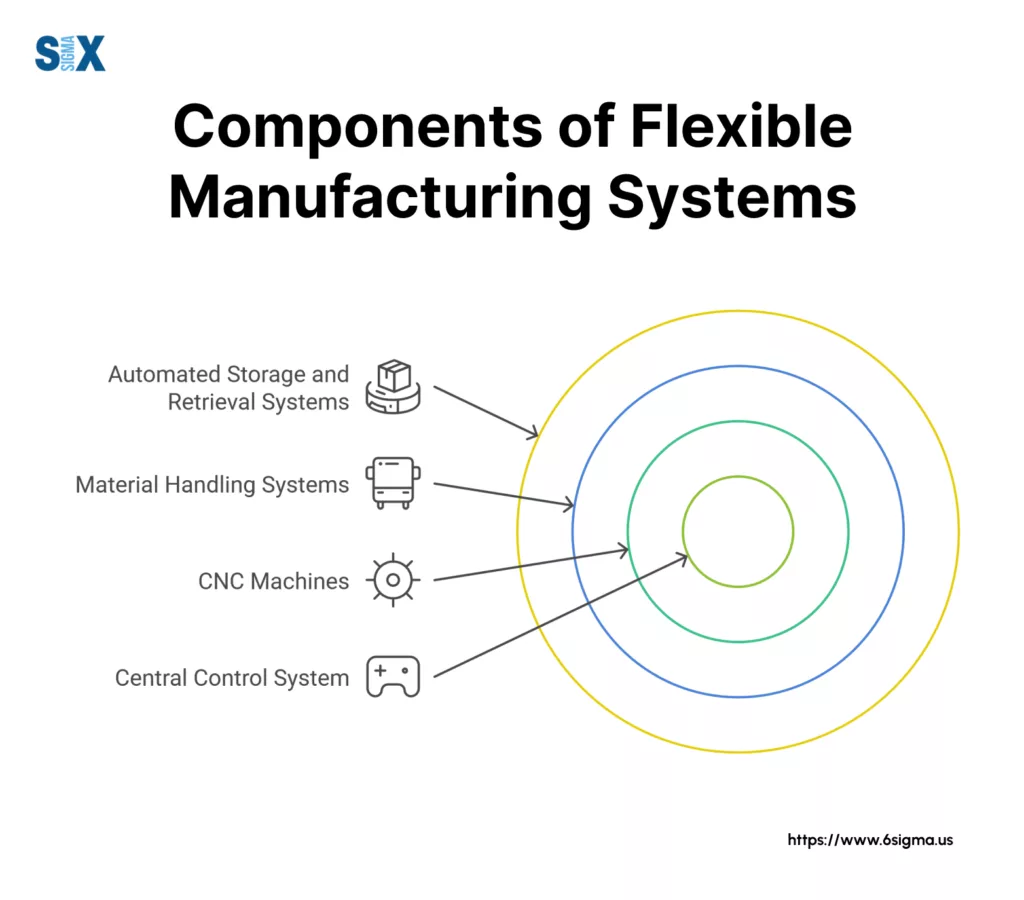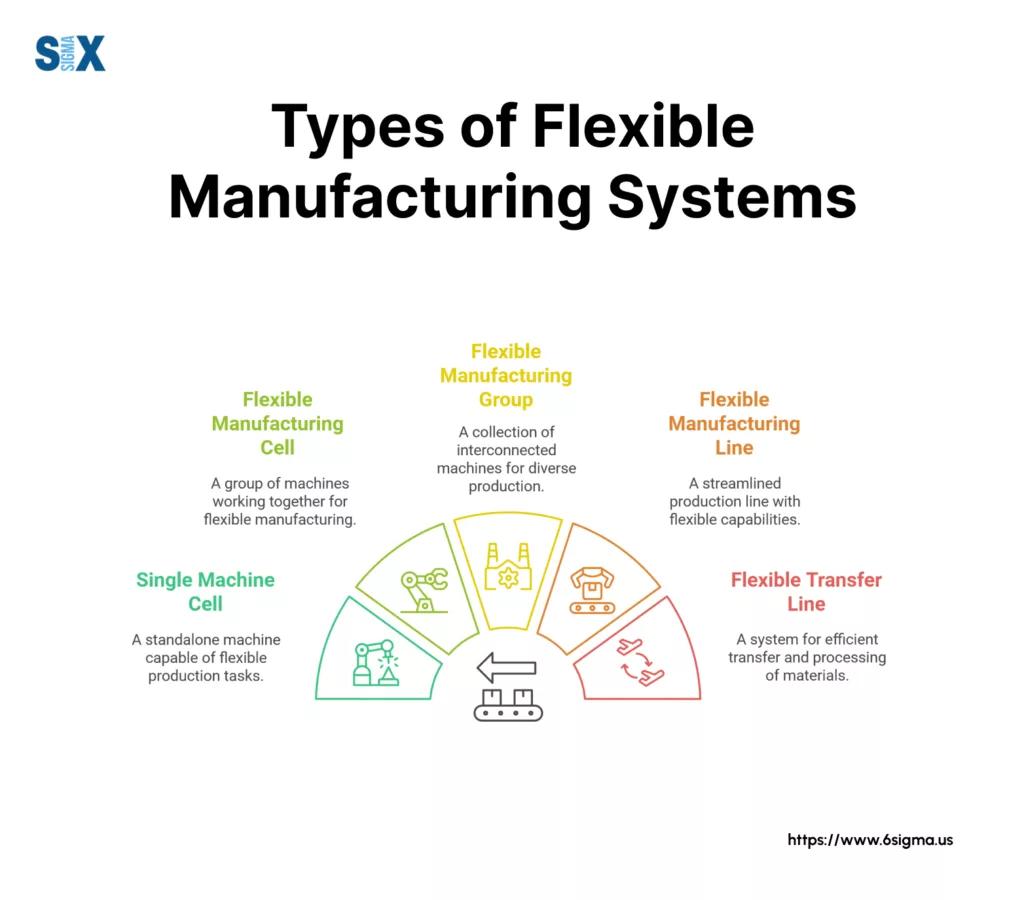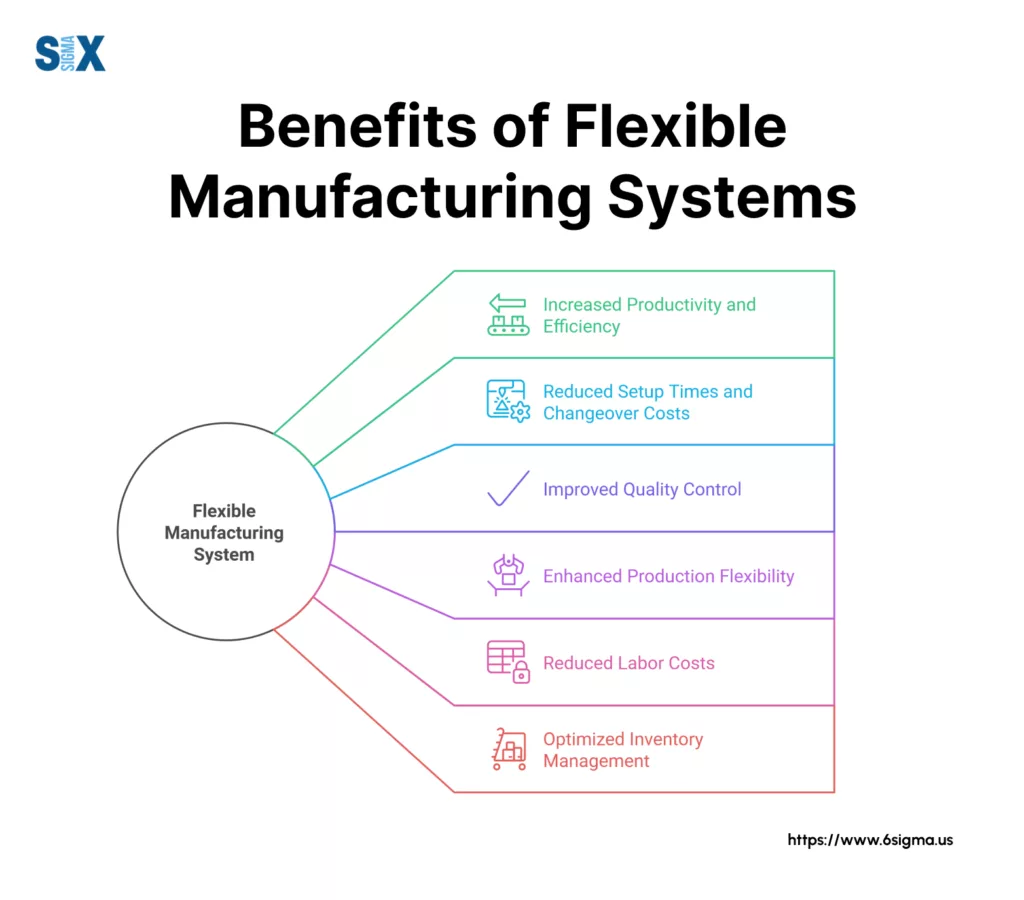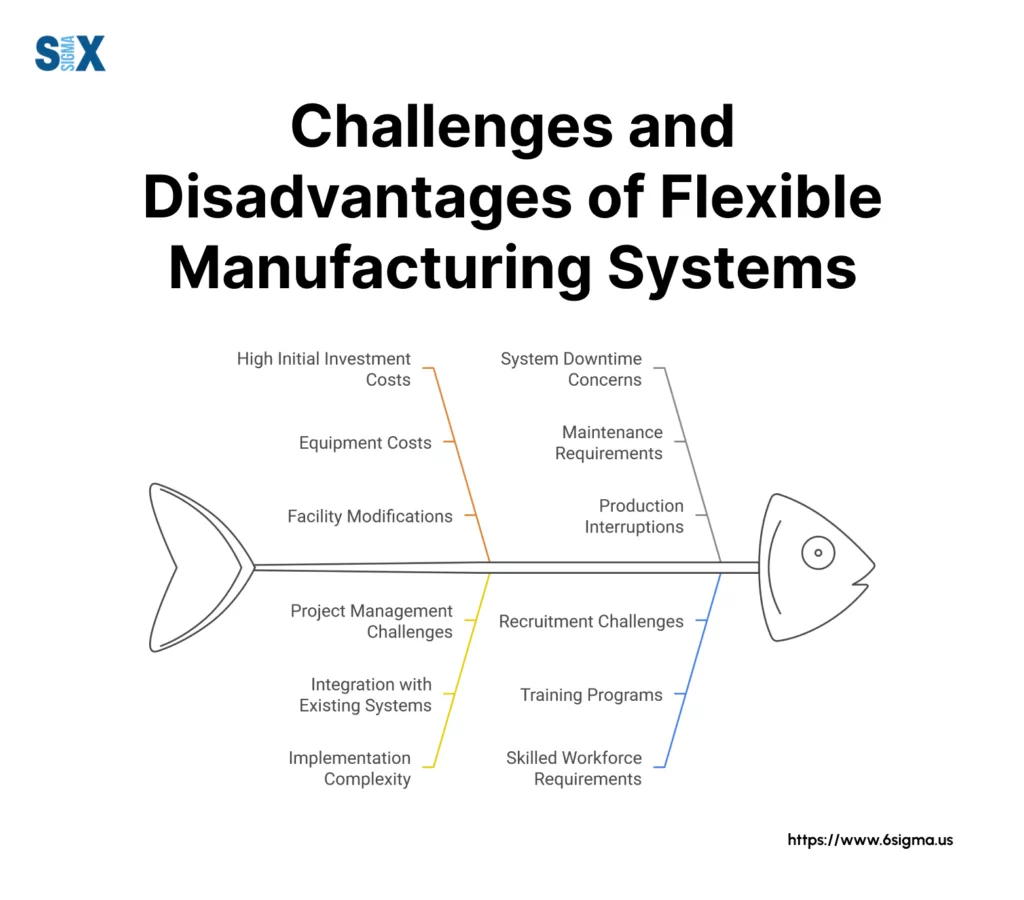Flexible Manufacturing System (FMS): The Ultimate Guide to Revolutionizing Production
Manufacturing has taken a new form post the introduction of Flexible Manufacturing System (FMS). Looking at it objectively, FMS goes beyond automation. It’s a core shift in the approach that represents flexibility and efficiency in manufacturing.
This article will equip you to:
- Breaking down Flexible Manufacturing System (FMS), components, and how it works
- Critical components and types of Flexible Manufacturing System (FMS)
- Benefits, challenges, implementation strategies, and case studies
What is a Flexible Manufacturing System?
A flexible manufacturing system or FMS is an integrated, computer-controlled manufacturing configuration that holds a mix of efficiency of automation with the adaptability of custom production. This ensures that manufacturing processes adapt quickly to product changes with minimal intervention, all while maintaining Six Sigma quality levels.

The concept of FMS emerged in the late 1960s, but I’ve observed its evolution from basic automated cells to today’s AI-enhanced smart manufacturing systems.
FMS installations can help companies achieve:
- Rapid product changeovers without significant downtime
- Dramatic reductions in inventory costs
- Enhanced quality control through consistent automated processes
- Improved resource utilization and labor efficiency
Key Operational Aspects
Several critical operational aspects distinguish FMS from traditional manufacturing systems:
Production Flexibility
Unlike rigid production lines, with FMS, companies can:
- Handle multiple product variants simultaneously
- Adjust production volumes in real-time
- Accommodate new products with minimal retooling
- Optimize resource allocation dynamically
Process Integration
FMS excels in:
- Seamless material flow management
- Integrated quality control
- Automated tool management
- Real-time production monitoring
Data-Driven Decision Making
Companies leverage FMS data for:
- Predictive maintenance scheduling
- Quality trend analysis
- Production optimization
- Resource allocation improvements
Flexible Manufacturing System (FMS) in Today’s Context
Successful FMS implementations typically deliver:
- Enhanced market responsiveness
- Improved capital utilization
- Reduced inventory levels
- Higher quality consistency
- Increased operational efficiency
The key to understanding FMS lies in recognizing it’s not just about automation – it’s about creating an intelligent, adaptive manufacturing environment.
Components of a Flexible Manufacturing System: A Master Black Belt’s Perspective
Understanding the core components of a flexible manufacturing system is crucial for successful deployment. These systems are far more than just automated machinery – they’re sophisticated networks of integrated components working in perfect synchronization.
A flexible manufacturing system consists of four primary components that I’ve seen revolutionize production floors across the globe.

Computer Numerical Control (CNC) Machines
Modern CNC machines form the backbone of any FMS. These programmable machines can perform multiple operations without manual intervention.
Material Handling Systems within a Flexible Manufacturing System
The automated material handling systems include:
- Automated Guided Vehicles (AGVs)
- Robotic arms and conveyors
- Smart pallet systems
- Automated tool changers
Automated Storage and Retrieval Systems (AS/RS)
These systems manage:
- Raw material storage
- Work-in-progress inventory
- Finished goods
- Tooling and fixtures
Central Control System
The central control system is what I often call the “brain” of the FMS. Based on my statistical analysis of numerous implementations, this component typically includes:
- Real-time production monitoring
- Quality control integration
- Resource allocation algorithms
- Predictive maintenance capabilities
The key to success lies in the seamless integration of these components. I’ve found that the most effective FMS installations achieve this through:
- Standardized communication protocols
- Robust error-handling systems
- Real-time data analytics
- Predictive maintenance capabilities
When properly implemented, these components work together to create a manufacturing system that can adapt to changing production requirements while maintaining consistent quality levels.
Types of Flexible Manufacturing Systems
Each type offers distinct advantages, and selecting the right configuration can significantly impact your operational success.

Single Machine Cell
The single-machine cell represents the fundamental building block of flexible manufacturing. I’ve found this configuration particularly effective for small-scale, high-precision operations. It excels in environments where product variety is moderate but quality requirements are stringent.
Flexible Manufacturing Cell (FMC)
Moving up in complexity, the flexible manufacturing cell combines multiple processing stations with integrated material handling. FMCs differ from single cells by offering greater processing capabilities and improved workflow management. They’re ideal for medium-sized operations requiring significant production flexibility.
Flexible Manufacturing Group (FMG)
Flexible manufacturing groups essentially network multiple FMCs together. The key distinction between FMGs and simpler cells lies in their enhanced coordination capabilities.
Flexible Manufacturing Line (FML)
The flexible manufacturing line configuration arranges processing stations in a linear sequence while maintaining routing flexibility. The linear arrangement provides excellent throughput for high-volume operations while maintaining the ability to handle product variants.
Flexible Transfer Line (FTL)
The most sophisticated configuration is the flexible transfer line. FTLs have proven exceptional for high-volume production with moderate variety requirements. These systems combine the speed of traditional transfer lines with flexible processing capabilities.
Selection Considerations of a Flexible Manufacturing System
Selecting the appropriate Flexible Manufacturing System (FMS) type depends on several critical factors. When consulting with clients, I evaluate:
- Production volume and variety requirements
- Available floor space and layout constraints
- Investment capacity and expected ROI
- Workforce capabilities and training requirements
- Future scalability needs
For example, when helping a small electronics manufacturer choose between an FMC and FMG, our analysis showed that an FMC would provide optimal ROI given their specific parameters.
How a Flexible Manufacturing System Work: An Expert’s Analysis
The operational flow of a flexible manufacturing system begins with the computer control system, which I often describe as the system’s central nervous system. This control system manages everything from production scheduling to quality control parameters.

Material handling within an FMS follows what I call the “intelligent flow principle”. The system automatically routes raw materials, work-in-progress, and finished products through the production process using automated guided vehicles (AGVs), conveyors, and robotic handling systems.
This automation eliminates the inefficiencies I frequently encountered in traditional manufacturing environments.
Process integration ensures that all manufacturing operations work in perfect synchronization.
The system’s ability to adapt to changes in real-time is what truly sets it apart. Effective FMS installations can typically:
- Adjust production parameters within milliseconds
- Reroute materials based on equipment availability
- Modify processing sequences to optimize throughput
- Maintain quality standards across different product variants
The feedback loop is another crucial element I always emphasize in my consulting work. Modern FMS installations collect and analyze data from every operation, creating what I call a “self-learning manufacturing environment”.
From my experience leading international projects, I can say that successful FMS operation requires a delicate balance of automation and human oversight. While the system handles routine operations autonomously, skilled operators and engineers play crucial roles in optimization and strategic decision-making.
Through careful integration of these operational elements, a flexible manufacturing system creates what I call a “responsive production ecosystem”. This ecosystem can adapt to changing production requirements while maintaining consistent quality levels – a capability that’s becoming increasingly crucial in today’s dynamic manufacturing environment.
Benefits of Flexible Manufacturing System (FMS): A Six Sigma Perspective
A flexible manufacturing system transforms operations and delivers substantial benefits. Let me share the key advantages that make FMS a game-changing investment.

Increased Productivity and Efficiency
Companies can expect productivity gains through FMS implementation. Results include:
- Increase in machine utilization
- Reduction in production cycle times
- Improvement in overall equipment effectiveness (OEE)
Reduced Setup Times and Changeover Costs
Companies can expect reduction in setup times through FMS implementation. Results include:
- Reduction in changeover times
- Decrease in setup-related costs
- Improvement in production scheduling flexibility
Improved Quality Control with a Flexible Manufacturing System
Companies can expect quality improvement through FMS implementation. Results include:
- Higher first-pass yield rates
- Reduction in quality-related defects
- Real-time quality monitoring and adjustment
Enhanced Production Flexibility
Companies can expect unprecedented production flexibility through FMS implementation. Results include:
- Reduction in lead times
- Improvement in product mix adaptability
- Faster new product introduction
Reduced Labor Costs with a Flexible Manufacturing System
Companies can expect significant labor cost reductions through FMS implementation. Results include:
- Decrease in direct labor costs
- Reduction in indirect labor expenses
- Improved worker productivity and satisfaction
Optimized Inventory Management
Companies can expect improved inventory management through FMS implementation. Results include:
- Reduction in work-in-progress inventory
- Decrease in finished goods inventory
- Improvement in inventory turnover
Want to Ensure Your FMS Delivers Consistent Quality?
Learn how to conduct effective capability studies through our specialized course. Understand process capability indices and how to use them to optimize your manufacturing system’s performance.
Challenges and Disadvantages of a Flexible Manufacturing System
While the benefits can be substantial, it’s crucial to understand and prepare for potential obstacles.

High Initial Investment Costs
The financial commitment required for FMS implementation is significant. Costs are required for:
- $2-5 million for basic systemsspos
- $5-15 million for medium-scale implementations
- $15-30 million for comprehensive enterprise solutions
Implementation Complexity of a Flexible Manufacturing System
Implementation complexity presents significant challenges like:
- Integration with existing systems required extensive modification
- Software compatibility issues emerged during the deployment
- Process standardization took longer than anticipated
- Change management proved more challenging than expected
System Downtime Concerns
System downtime is a critical challenge. Typically:
- Initial system stabilization typically takes 3-6 months
- Unplanned downtime can affect entire production lines
- Recovery from major system failures can be complex
- Maintenance windows must be carefully planned
Skilled Workforce Requirements for a Flexible Manufacturing System
Perhaps the most persistent challenge is the need for skilled personnel. FMS operations require:
- Advanced technical knowledge
- Programming and troubleshooting capabilities
- System integration expertise
- Continuous learning mindset
Want to Minimize Risks in Your FMS Implementation?
Master FMEA to identify and prevent potential system failures before they impact your operations. Start our comprehensive FMEA course today and learn how to protect your manufacturing investment.
Comparing Flexible Manufacturing System with Other Production Methods
I’ve had the unique opportunity to evaluate and compare various production methodologies. Let me share insights gained from implementing a flexible manufacturing system alongside other manufacturing approaches.
FMS vs. Traditional Manufacturing

After conducting extensive comparative analyses between FMS and traditional manufacturing methods. The results were compelling:
- FMS reduced setup times by 75% compared to traditional methods
- Production flexibility increased by 60%
- Quality consistency improved to Six Sigma levels
- Inventory carrying costs decreased by 45%
However, traditional manufacturing still holds advantages in situations requiring simple, high-volume production of standardized products. This is something I often emphasize in my consulting work when helping companies choose the right manufacturing approach.
FMS vs. Rigid Automation

Implementing both FMS and rigid automation systems has revealed distinct differences. While rigid automation excels in high-volume, single-product scenarios, FMS offers significant advantages:
- Product changeover times reduced from days to hours
- Higher equipment utilization rates
- Greater ability to handle product variations
- Lower total cost of ownership over system lifetime
FMS vs. Lean Manufacturing

The most interesting comparison, based on my Six Sigma background, is between FMS and lean manufacturing. These methodologies can be highly complementary. The integrated approach achieved:
- Reduction in waste
- Improvement in throughput
- Decrease in work-in-progress inventory
- Enhancement in quality metrics
Key Selection Criteria for a Flexible Manufacturing System
I recommend considering these factors when choosing between manufacturing systems:
- Production volume requirements
- Product variety needs
- Quality requirements
- Available investment capital
- Workforce capabilities
- Market dynamics
Industries and Applications of a Flexible Manufacturing System
There is a transformative impact of flexible manufacturing system across diverse industries.

Automotive Industry
The automotive sector has been at the forefront of FMS adoption. A major automotive manufacturers observed remarkable improvements:
- 45% reduction in model changeover times
- 35% increase in production flexibility
- 60% improvement in quality consistency
- 40% decrease in inventory costs
At one particular automotive plant, we implemented an FMS that could handle 12 different vehicle models on the same production line – a feat that would have been impossible with traditional manufacturing methods.
Aerospace Manufacturing
The aerospace industry presents unique challenges that FMS is particularly well-suited to address. They achieved:
- 55% improvement in precision machining accuracy
- 40% reduction in production lead times
- 65% decrease in setup times for complex components
- 30% increase in overall equipment effectiveness
Electronics Production
In the electronics sector, FMS has revolutionized production capabilities:
- 70% faster new product introduction
- 45% reduction in assembly time
- 50% improvement in quality metrics
- 35% decrease in manufacturing costs
An implementation at a major electronics manufacturer enabled them to produce 15 different product families on a single FMS line, dramatically improving their market responsiveness.
Medical Device Manufacturing
The medical device industry, with its strict quality requirements, has been particularly receptive to FMS solutions. A client achieved:
- 99.99% quality compliance rates
- 40% reduction in validation times
- 55% improvement in production flexibility
- 30% decrease in regulatory-related delays
One notable implementation enabled a medical device manufacturer to reduce their time-to-market for new products by 60% while maintaining full FDA compliance.
Other Industries Benefiting from Flexible Manufacturing System (FMS)
Successful FMS implementations in:
Consumer Goods
- ~45% improvement in packaging flexibility
- ~35% reduction in changeover times
- ~50% increase in product customization capabilities
Heavy Equipment
- ~40% reduction in manufacturing lead times
- ~55% improvement in component quality
- ~30% decrease in production costs
Chemical Processing
- ~65% improvement in batch changeover efficiency
- ~45% reduction in material waste
- ~50% increase in process control accuracy
The key to successful FMS implementation across these industries lies in what I call “adaptive optimization” – tailoring the system to industry-specific requirements while maintaining flexibility.
Implementing a Flexible Manufacturing System: An Implementation Guide
I’ve developed a comprehensive approach to FMS implementation.

Phase 1: Assessing Manufacturing Needs and Goals
The foundation of successful FMS implementation begins with thorough assessment. A systematic evaluation process should includes:
1. Current State Analysis
- Production volume requirements
- Product mix flexibility needs
- Quality metrics and targets
- Resource utilization patterns
2. Future State Definition
- Growth projections
- Market demand forecasts
- Technology roadmap alignment
- Capacity requirements
Phase 2: Designing the FMS Layout
Layout design is critical for optimal performance. At Intel, our design methodology focused on:
1. Process Flow Optimization
- Material movement minimization
- Work-in-progress optimization
- Quality checkpoint integration
- Maintenance access planning
2. Space Utilization
- Equipment positioning for maximum efficiency
- Buffer zone optimization
- Future expansion accommodation
- Utility access planning
Phase 3: Selecting and Integrating Components
Component selection requires careful consideration of multiple factors. Key considerations include:
1. Equipment Selection
- Performance requirements
- Integration capabilities
- Maintenance requirements
- Future upgrade potential
2. System Integration
- Communication protocols
- Control system architecture
- Data collection capabilities
- Quality monitoring systems
Ready to lead FMS implementation projects?
Our Green Belt certification covers crucial tools like Process Variables Mapping, Statistical Process Control, and Capability Analysis – essential skills for optimizing a flexible manufacturing system.
Phase 4: Training Personnel
Through my experience training thousands of professionals, a comprehensive training program should include:
1. Technical Training
- System operation procedures
- Maintenance protocols
- Troubleshooting methods
- Quality control processes
2. Process Management
- Production scheduling
- Performance monitoring
- Problem-solving techniques
- Continuous improvement methods
Phase 5: Testing and Optimization
The final phase focuses on system validation and optimization. Implement a rigorous testing protocol:
1. System Validation
- Component-level testing
- Integration testing
- Performance verification
- Quality validation
2. Process Optimization
- Cycle time reduction
- Quality improvement
- Efficiency enhancement
- Cost optimization
Key Success Factors for a Flexible Manufacturing System
Success depends on:
- Clear project governance
- Stakeholder engagement
- Risk management
- Change management
- Performance monitoring
Implementation Timeline
A typical FMS implementation following this framework takes:
- Assessment: 4-6 weeks
- Design: 8-12 weeks
- Integration: 12-16 weeks
- Training: 8-12 weeks
- Optimization: 4-8 weeks
The key is maintaining a balance between technical excellence and operational practicality while ensuring continuous alignment with business objectives.
ROI Analysis and Cost Considerations for Flexible Manufacturing System
Here’s a comprehensive framework for analyzing the financial aspects of flexible manufacturing system.

Initial Investment Breakdown
A typical FMS investments include:
- Hardware costs: 45-55% of total investment
- Software and integration: 20-25%
- Installation and commissioning: 15-20%
- Training and documentation: 8-12%
Long-term Cost Savings with a Flexible Manufacturing System (FMS)
I’ve achieved and seen consistent cost savings across various areas:
- Labor costs: 30-40% reduction
- Inventory carrying costs: 25-35% decrease
- Quality-related costs: 40-50% improvement
- Maintenance costs: 20-30% reduction
ROI Calculation Methodology
A comprehensive ROI calculation model that considers:
- Direct cost savings
- Productivity improvements
- Quality enhancements
- Market responsiveness benefits
Typical ROI metrics include:
- Payback period: 2-4 years
- Internal rate of return: 25-35%
- Net present value: Positive within 18-24 months
Key Profitability Factors
Critical factors affecting FMS profitability:
- Utilization rates (target >85%)
- Product mix flexibility
- Market demand stability
- Maintenance efficiency
- Workforce productivity
Flexible Manufacturing System (FMS) in Modern Industry
The most significant benefits of FMS consistently include:
- Improvement in production flexibility
- Reduction in operating costs
- Increase in quality metrics
- Enhancement in market responsiveness
However, we must acknowledge the challenges:
- Significant initial investment requirements
- Complex implementation processes
- Need for skilled personnel
- Ongoing maintenance considerations
Future of Manufacturing with Flexible Manufacturing System (FMS)
I see FMS playing an increasingly crucial role in the future of manufacturing. Key trends I’m observing include:
- Integration with artificial intelligence and machine learning
- Enhanced predictive maintenance capabilities
- Greater emphasis on sustainability
- Improved customization capabilities
Making the FMS Decision
I recommend considering:
- Current manufacturing challenges
- Future growth projections
- Market demand patterns
- Available resources and capabilities
- Long-term strategic objectives
Going Ahead
Flexible manufacturing system(s) represent more than just a technological advancement – they’re a fundamental shift in how we approach production efficiency and market responsiveness.
The key to success lies in what I call the “three pillars of FMS excellence”:
- Thorough planning and preparation
- Systematic implementation
- Continuous optimization
SixSigma.us offers both Live Virtual classes as well as Online Self-Paced training. Most option includes access to the same great Master Black Belt instructors that teach our World Class in-person sessions. Sign-up today!
Virtual Classroom Training Programs Self-Paced Online Training Programs






